

I don't know the complete history of why the Meyers Manx was designed to be 14-1/4 inches shorter than a stock VW but I am sure that the result is the Manx has amazing off-road handling characteristics. Whatever inspired Bruce has provided us with endless hours fun.
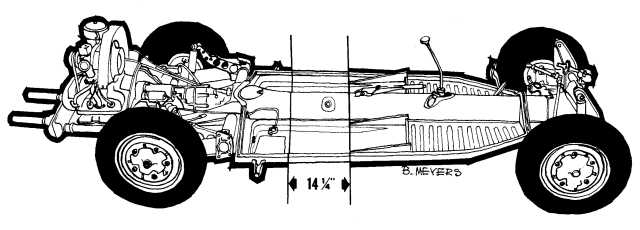
The VW Bug combines a body shell and chassis to implement a very rigid "monocoque" body. The VW is not a true "monocoque" because the body can be removed by simply un-bolting it. The remaining chassis is called the "pan". The pan consists of a central steel tunnel with front and rear assemblies for attaching suspension components and a thin sheet metal floor plate to form the bottom of the car. When the body is removed, the central tunnel of the pan is the only remaining structural component between the front and rear of the chassis. The tunnel is not a completely rigid structural component in that it will allow some torsion to occur between the front and rear of the frame.
When shortening the pan it is extremely important to correctly weld the tunnel back together to restore the structural integrity of the frame. When a fiberglass body is bolted to the frame it regains some of the "monocoque" characteristics but it is not nearly as rigid as the original VW Bug. If the tunnel is not correctly welded and strengthened, the car is very likely to break in half. A MIG wire-feed welder is recommended for the welding; however, I have done the job by steel brazing with oxygen-acetylene gas. An arc welder is not recommended because the material is so thin that an arc welder will just melt holes in the metal. It is also very important to keep the alignment of the frame intact. I always spend more time measuring for accurate alignment than I spend welding.
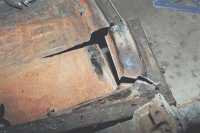 The location on the frame where the 14-1/4 inches is to be removed is
the straight section of the tunnel directly behind the emergency brake
handle on a line even with the rear of the seat support rails. When
examining the pan it is obvious that because the sides of the VW pan are
not parallel, the two halves are not going to exactly match when they
are put back together. There are several ways to accomplish this feat.
The method that I am going to describe entails cutting out 14-1/4 inches
straight across the frame and then cutting darts out of the rear half to
make the two sides match.
The location on the frame where the 14-1/4 inches is to be removed is
the straight section of the tunnel directly behind the emergency brake
handle on a line even with the rear of the seat support rails. When
examining the pan it is obvious that because the sides of the VW pan are
not parallel, the two halves are not going to exactly match when they
are put back together. There are several ways to accomplish this feat.
The method that I am going to describe entails cutting out 14-1/4 inches
straight across the frame and then cutting darts out of the rear half to
make the two sides match.
The body is removed from the frame by first removing all the bolts from the channel under the outer edge of the frame (an air powered impact wrench does this quickly). There are also four bolts that must be removed the middle of the underside of the car that are just in front of the rear torsion bar housing. Then remove the two bolts under the rear wheel wells that attach the body to the rear cast suspension members. There are also two bolts under the rear seat of the car that attach to the rear cast suspension members. The last two bolts are located in front of the gas tank and connect to the top of the front suspension beams. Before you can lift the body off, you must disconnect the steering shaft at the steering box, remove the speedometer cable, disconnect the heater box control wires, and all remove the wiring that connects to the engine and the master brake cylinder.
The next task is to lift the body off the chassis. There are several ways to do this. The method I chose in 1966 was to hook a winch to the rafters of my dad's garage. I succeeded in breaking the rafter and collapsing the roof of the garage onto the VW ! It is better to get four helpers, two 12 foot 2X6's, and four saw horses. First, lift the front of the body off the fame and slip a 2X6 under the wheel wells and support it on each side with saw horses. Then do the same thing at the rear of the car. When the body is high enough in the air, the frame can be rolled out from under it. I recently removed a body by myself by building a large wood frame and using a "come-along" to winch the body into the air.
The frame now needs to be cleaned and prepared before shortening begins. The engine must be removed because it is heavy and the pan must be turned over to weld the bottom. Open the access hole at the front of the frame between the front torsion bar tubes and remove the shift rod after detaching it from the front of the transmission. Leave the front suspension on the pan to provide necessary points for measuring and aligning the chassis. Clean the thick tar based sound deadening material from the entire pan so that the metal can be cleaned of rust and eventually painted. The tar can be removed by using a chisel and hammer, but an air chisel does this quickly. The tar can also be removed by heating the metal near the tar to cause it to melt away from the metal (this is a stinky process). You must then remove the rear brake drums and take out the emergency brake cables. Disconnect the hydraulic brake line at the tee connector on the rear suspension fork. Pull the brake line toward the front of the chassis by bending open the tabs that hold the line to the pan. You will also have to remove the foot pedal assembly to remove the clutch cable and accelerator cable.
 Once the pan is clean, the next step is to support it about 2 feet
off the ground so that it is perfectly level and convenient for cutting
and welding. To level the pan, place a bubble level on the straight
part on top of the tunnel in front of the shift lever and adjust the
supports front and rear to center the bubble. The flat part of the
tunnel just in front of the rear access hole should also be level. The
pan must also be leveled from side to side. This is accomplished by
first placing a straight edge across the shock towers of the front
suspension and then adjusting for side to side level.
Then place a straight edge across the rear
cast suspension mounts to level the rear of the pan.
Once the pan is clean, the next step is to support it about 2 feet
off the ground so that it is perfectly level and convenient for cutting
and welding. To level the pan, place a bubble level on the straight
part on top of the tunnel in front of the shift lever and adjust the
supports front and rear to center the bubble. The flat part of the
tunnel just in front of the rear access hole should also be level. The
pan must also be leveled from side to side. This is accomplished by
first placing a straight edge across the shock towers of the front
suspension and then adjusting for side to side level.
Then place a straight edge across the rear
cast suspension mounts to level the rear of the pan.
Now make criss-cross measurements to verify that the frame is straight. Measure the distance from the top of one front shock tower to one of the body attachment bolt holes in the opposite rear cast suspension mounts. Repeat the measurement using the other front shock tower and opposite rear mounting bolt hole. The measurements should be the same within an 1/8 inch or so. We will repeat this process to guarantee alignment after the 14-1/4 inches have been removed and the two halves are pushed together.
 To make a template for marking the pan section to be removed, cut a
piece of construction paper exactly 14-/4 inches wide and about 30
inches long. Lay the template on the floor pan with one of the long
edges just touching the rear of the seat support rails. Use a silver
drawing pencil to draw two parallel lines from the side of the pan over
to the bottom edge of the tunnel.
To make a template for marking the pan section to be removed, cut a
piece of construction paper exactly 14-/4 inches wide and about 30
inches long. Lay the template on the floor pan with one of the long
edges just touching the rear of the seat support rails. Use a silver
drawing pencil to draw two parallel lines from the side of the pan over
to the bottom edge of the tunnel.
Repeat the procedure on the other side of the pan. Now lay the paper over the tunnel about two inches behind the emergency brake bracket. Line up the template so that the edges of the paper match the lines just drawn on the floor pan. Use the silver drawing pencil to trace the edge of the paper over the tunnel at the front and rear of the paper template.
It is now time to cut using a reciprocating "sawsall" (an air powered
cutting tool can also be used). It is important to not cut through the tubes
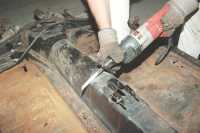 that are located inside the tunnel so special care will have to be taken to
locate and avoid them. Use the saw to just barely cut through the front top
corners of the tunnel just behind the emergency brake. Stick a hacksaw blade
through the cut to feel where it is safe to cut. You can also shove a "snake
light" into the rear access cover to illuminate the interior of the tunnel.
When you know where it is safe to cut, go ahead and cut down the sides of the
tunnel. The rear cut is trickier because the tubes for the emergency brake are
flush with the sides of the tunnel.
Be extremely careful to cut through only the tunnel and not through the tubes.
During the cutting process a helper should apply oil to the saw blade so that
the job uses a couple of blades rather than a dozen. To remove the tunnel
section you must saw along the bottom just flush with the floor.
that are located inside the tunnel so special care will have to be taken to
locate and avoid them. Use the saw to just barely cut through the front top
corners of the tunnel just behind the emergency brake. Stick a hacksaw blade
through the cut to feel where it is safe to cut. You can also shove a "snake
light" into the rear access cover to illuminate the interior of the tunnel.
When you know where it is safe to cut, go ahead and cut down the sides of the
tunnel. The rear cut is trickier because the tubes for the emergency brake are
flush with the sides of the tunnel.
Be extremely careful to cut through only the tunnel and not through the tubes.
During the cutting process a helper should apply oil to the saw blade so that
the job uses a couple of blades rather than a dozen. To remove the tunnel
section you must saw along the bottom just flush with the floor.
Don't cut up this piece because we will use it later to strengthen the tunnel. Use a disk grinder to cut a slot in the tunnel so that the saw blade can be inserted.
Once the top of the tunnel has been removed, put supports under the middle of the car and cut the sections out of the sheet metal floor.
It is best to cut the floor just inside the lines so that there will be a slight overlap when the halves are put back together. Then use a straight edge to draw two lines on the remaining bottom section of the tunnel and cut it out.
Before the two halves can be pushed together, the control tubes must be modified. At the rear access cover, measure how far the clutch and accelerator tubes extend out behind the chassis and then cut them away (not off) from the bracket that holds them to the tunnel. Remove the rubber grommet where the fuel line sticks out of the rear transmission fork. When the halves get pushed together, these lines will be pushed back and extended further out the holes from which they currently protrude. Cut off the tubes that are used to control the heater vents (unless you live in Canada). Use the sawsall with a long blade (12") to reach into the rear section of the tunnel and cut the bracket that holds the gas line.
The emergency brake tubes require some special consideration. What you do next depends on whether you can obtain or make shortened emergency brake cables. To make shortened cables you must obtain new cable ends and have them swaged onto the shortened cables with a special tool (this might be accomplished at a yachting supply company).
If you can get shortened cables, you want to keep the tubes intact all the way up to the rear of the hand brake cable opening. Measure the distance from the forward tunnel cut to the front of the emergency brake tubes. Mark this distance on the emergency brake tubes from the rear tunnel cut and sever the tubes at this point. Use the sawsall to cut the bracket inside the tunnel just behind the emergency brake lever hole and then remove the short sections of the tubes. Then put a hose clamp around the front of the remaining emergency brake tubes so they will come together just behind the brake handle when the pan halves are shoved together.
If you can not get shortened cables, the full length cables will be used and coiled up inside the tunnel. In this case cut the emergency brake tubes just behind the front tunnel cut leaving the short section attached under the rear of the brake handle. Next cut the emergency brake tubes about eight to ten inches inside the rear pan section and remove the loose pieces of tubing. Use the sawsall to enlarge the rear tunnel access hole (not larger than the size of the cover plate) so that it is possible to get your hand in there later to coil the cable and put on cable clamps.
It is now possible to push the two pan halves together. Keep the halves
well supported so that they do not fall and bend the tubing. While
 pushing the halves together, carefully pull the clutch, accelerator, and
fuel lines out of their respective openings. When the halves are
together, check for any mismatches that may need to be ground off with
a welding grinder. It is now time check for alignment again. Use the
bubble level to adjust the top of the tunnel at the front and rear as
was done earlier.
pushing the halves together, carefully pull the clutch, accelerator, and
fuel lines out of their respective openings. When the halves are
together, check for any mismatches that may need to be ground off with
a welding grinder. It is now time check for alignment again. Use the
bubble level to adjust the top of the tunnel at the front and rear as
was done earlier.
Level the front of the chassis by using the straight edge across the top of the front shock towers. Level the rear of the car using a straight edge across the rear cast suspension mounts. Make the criss-cross measurements to verify that the chassis is straight.
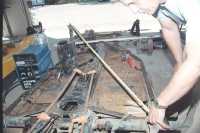 There should be no more that 1/16 inch separation at the tunnel joint.
If there is more than that, slide the halves apart and use the welding
grinder to remove excess metal. At the corners there will be up to 1/2"
mismatch due to the difference in the shape between the front and rear
halves. We will heat the corners with a torch and bend them into place
during the welding. Put the halves back together and re- measure. The
halves can be put together under tension by using pipe clamps between
the hand brake hole and the access hole on the top of the tunnel. The
bottom can be put under tension by attaching a "come-along" under the
pan from the front suspension to a chain attached to the rear forks.
There should be no more that 1/16 inch separation at the tunnel joint.
If there is more than that, slide the halves apart and use the welding
grinder to remove excess metal. At the corners there will be up to 1/2"
mismatch due to the difference in the shape between the front and rear
halves. We will heat the corners with a torch and bend them into place
during the welding. Put the halves back together and re- measure. The
halves can be put together under tension by using pipe clamps between
the hand brake hole and the access hole on the top of the tunnel. The
bottom can be put under tension by attaching a "come-along" under the
pan from the front suspension to a chain attached to the rear forks.
Once the halves are tightly together and aligned, the welding process can begin. Tack weld the top center of the tunnel and then the straight sections of the tunnel sides where they are evenly matched. Now use an oxygen-acetylene torch to heat the mismatched sections and beat them into place with a hammer. Alternate between welding and heating with the torch until the tunnel is completely welded on the top side. There may be up to 1/2" gap where the two floors meet at the bottom edge of the tunnel. This will require some extra heat and a 5 pound hammer to get the edges close enough to weld. Now turn the chassis over and weld the bottom edge of the tunnel together.
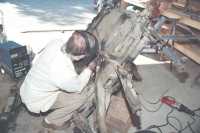 The thin sheet metal floor can now be welded; however, a dart must be
cut out of the rear corner before the outside edges of the pan will come
together. Draw a line from the rear outside corners of the rear pan
sections down along the inside radius of the corner to the bottom of the
floor pan. Then extend the line straight and parallel to the outside
edge forward to the cut between the halves. Use the sawsall to cut
along this line so that the rear corner is loose but not cut all the way
off. Now fold the loose corner in until the outside edges of the pan
match. Use the silver pencil to draw a line on the overlapped portion
of the rear section. Pull out the loose corner and cut off the excess
material at the marked line with tin shears. Now fold the loose corner
back in place; clamp it; and weld it.
The thin sheet metal floor can now be welded; however, a dart must be
cut out of the rear corner before the outside edges of the pan will come
together. Draw a line from the rear outside corners of the rear pan
sections down along the inside radius of the corner to the bottom of the
floor pan. Then extend the line straight and parallel to the outside
edge forward to the cut between the halves. Use the sawsall to cut
along this line so that the rear corner is loose but not cut all the way
off. Now fold the loose corner in until the outside edges of the pan
match. Use the silver pencil to draw a line on the overlapped portion
of the rear section. Pull out the loose corner and cut off the excess
material at the marked line with tin shears. Now fold the loose corner
back in place; clamp it; and weld it.
 To strengthen the tunnel weld, cut one 1-1/2 inch wide strip from the
removed tunnel piece and weld it over the top of the tunnel weld. If
the pan has slots next to the emergency hand brake for heater controls,
these slots must be welded shut and strengthened. Cut the remaining
piece of the tunnel lengthwise into 1-1/2 inch wide strips. Weld one
strip on each side of the tunnel on the vertical surface just below the
hand brake opening. The cut narrow strips and weld them over the heater
slots and to the upper edge of the straps that were just welded into
place.
To strengthen the tunnel weld, cut one 1-1/2 inch wide strip from the
removed tunnel piece and weld it over the top of the tunnel weld. If
the pan has slots next to the emergency hand brake for heater controls,
these slots must be welded shut and strengthened. Cut the remaining
piece of the tunnel lengthwise into 1-1/2 inch wide strips. Weld one
strip on each side of the tunnel on the vertical surface just below the
hand brake opening. The cut narrow strips and weld them over the heater
slots and to the upper edge of the straps that were just welded into
place.
The last detail is to shorten the clutch, accelerator, and fuel lines
that are sticking out the rear of the chassis. Use the measurements for
correct length that were made before the chassis was cut in half.
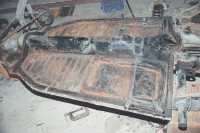 Re-install the fuel line grommet to keep it from rattling and braze the
clutch and accelerator cables tubes to the edge of the pan just under
the rear access cover.
Don't forget that the shift rod must also be
shortened 14-1/4 inches. When you shorten the rod, scribe a horizontal
line on the rod before you cut it to be sure that the two halves go back
together without any twist. Install a new nylon shift rod bushing
inside the tunnel just behind the shifter opening before putting the
shift rod back in place.
Re-install the fuel line grommet to keep it from rattling and braze the
clutch and accelerator cables tubes to the edge of the pan just under
the rear access cover.
Don't forget that the shift rod must also be
shortened 14-1/4 inches. When you shorten the rod, scribe a horizontal
line on the rod before you cut it to be sure that the two halves go back
together without any twist. Install a new nylon shift rod bushing
inside the tunnel just behind the shifter opening before putting the
shift rod back in place.
I find that cleaning the pan before painting is best accomplished with a heavy duty wire cup brush on a welding grinder (sand blasting is optimum). After a good coat of rubberized undercoating on the bottom and rust inhibitor paint to the top you are now ready to Rock and Roll (roll over rocks) !